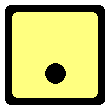 |
 |
PUNCTUATION |
|||||
|
|
|||||||
|
Full stops
Sentences are terminated with a full stop.
Unfortunately, some people have difficulty in deciding when the sentence has come to an end. The most common error is to write sentences that are too long, perhaps punctuating them with commas instead of full stops.
A sentence should make a statement.
John ran to the dining room.
The sentence may be qualified (or added to), as in the following examples.
Realising he was late for dinner, John ran to the dining room. John ran to the dining room, wishing he had left his friend's house earlier.
When the statement has been made, the sentence should come to an end.
Although there is no substitute for understanding grammatical structure, a useful ploy is to read your work aloud in a clear and measured manner - as if you were a TV newsreader. It should then become apparent where the sentence-breaks need to be. Read your work again, only pausing where there are full stops or commas (more of which later). If you find yourself running short of breath, it may mean that you need to reconsider the length of your sentences and perhaps re-write your work.
Remember: when a sentence is terminated with a full stop, the next sentence should start with a capital letter.
|
|||||||
|
Introduction - Capital letters - Full stops - Question Marks - Exclamation marks - Abbreviations - Contractions - Commas - Speech marks (Quotation marks - Inverted comas) - Possessive apostrophes - Colons - Semi-colons - Brackets - Hyphens - Dashes - Obliques (slashes)
|
|||||||
|
|
|||||||
